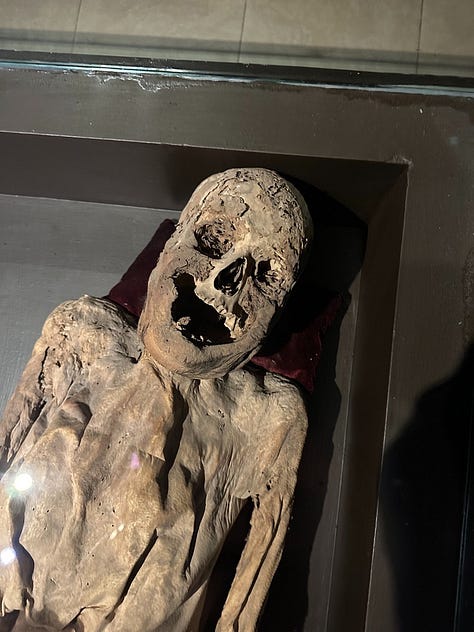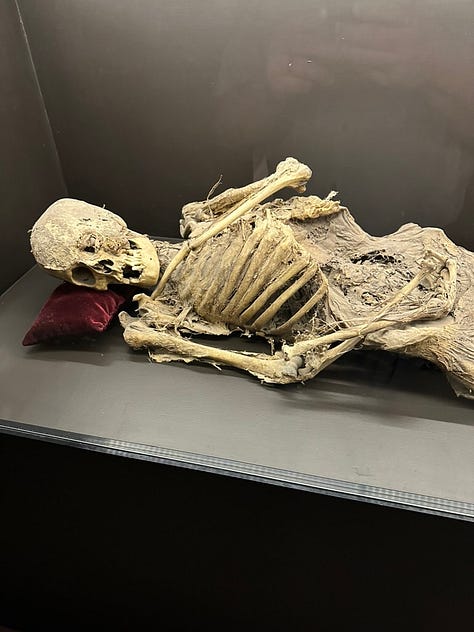Mummies
Fascination with death.
Death is treated differently depending on where you go and what your cultural traditions are. In the U.S. death is generally avoided. We know it is out there somewhere coming for all of us, but we would rather not talk about it. Some psychological schools talk about “death anxiety” as a core element of many psychological disorders.

In Mexico, death is much more out in the open. On November 2 each year, they celebrate Dia de los Muertos, or the Day of the Dead. This is a celebration of relatives and loved ones who have died, and the belief is that the spirits of the dead return each year on that day to visit their living families. (See the Disney movie Coco for an animated story which shows some of the most important concepts.) Skeleton figures dressed in fancy garments called Catrinas are seen in Mexican cities all year round.
In Guanajuato, there is a museum of mummies called Museo de las Momias. These aren’t royalty like Egyptian mummies. In the late 1800s, the government introduced a burial tax, and if it was not paid, bodies were exhumed. It is believed that the minerals in the soil caused a natural mummification process for the 70-plus mummies that were found among the decomposed corpses.



Some visitors call the museum creepy, and I understand that reaction. The visitors that I saw at the museum were more respectful than anything. Some of the mummies are displayed in the clothes they were buried in. Others have contorted faces that raise questions about the manner of their death. These mummies are considered a national treasure in Mexico. People come from around the world to see them. It’s just one more example of how death is more openly considered in Mexico.
In my work with cancer patients, I have been struck by how often a diagnosis changes them, often toward thoughts of spirituality, family relationships, and purpose in life. Psychologists have called this a shift to intrinsic goals rather than the extrinsic accumulation of goods and wealth. William S. Breitbart published a study that showed that cancer patients focused on meaning in life did better on measures of peace and faith, as well as reducing anxiety and concerns about death.
Existential psychotherapists like Irvin Yalom work with their patients to talk about mortality and think together about how to develop meaningful lives in the face of death. It turns out that thinking about death — not obsessing over it, but thinking about it — can actually give deeper meaning to life. If there is a constant low-level awareness of death as in Mexico, then anxiety about death may be reduced, and we will all give greater value to the daily activities of life.
I recently re-read Hamlet, and I had forgotten just how many people die in that play. King Hamlet, Polonius, Ophelia, Rosencrantz, Guildenstern, Laertes, Gertrude, Claudius, and Prince Hamlet all die. In the play, Hamlet contemplates the meaning of death, exemplified by his soliloquy while holding the skull of Yorick, the court jester of his youth. He says, “Alas, poor Yorick! I knew him, Horatio; a fellow of infinite jest, of most excellent fancy; he hath borne me on his back a thousand times; and now, how abhorred in my imagination it is! My gorge rises at it. Here hung those lips that I have kissed I know not how oft. Where be your gibes now? Your gambols? Your songs? Your flashes of merriment, that were wont to set the table on a roar?” The play shows the interplay between love and grief, ambition and jealousy. Characters die for all kinds of reasons, and some of those reasons are unresolved.
Figuring out the meaning of death will be different for everyone, but not thinking about it leads to greater anxiety and more difficulty in life. We will all die. It’s worth thinking about what that means for us personally, and what we want to do in the meantime.


